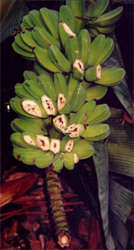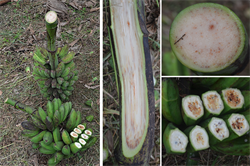- Narrow. Philippines. Major disease of bananas, plantains, Heliconia, and weeds.
- Bacterium identical to that causing moko disease (see Fact Sheet no. 525) of Cavendish bananas (AAA) grown on plantations, whereas bugtok attacks plantains (ABB, e.g., Cordaba) and BBB, e.g., Saba) grown by smallholders (see Acknowledgement for abbreviations). Bugtok threatens food security, and crop diversity.
- Leaves and fruits appear normal; leaf-like ‘bracts’ over male flowers fail to fall, fruit stems blacken, dry and distort, and inside of stems develop brown streaks in the vascular tissues. If fruit are present, the pulp may show brown or reddish rots, but not premature ripening (see Fact Sheet no. 523) and, occasionally, vascular streaking occurs in leaf sheaths (main stem), but leaves do not wilt.
- Spread: insects; unlikely in water or in suckers. Biosecurity: risk from unofficial introduction of diseased cuttings for propagation, and trade in fruit. Official movement of germplasm should always follow the FAO/IPBGR Technical Guidelines.
- Biocontrol: none.
- Cultural control: most important recommendations for smallholders are: (i) monitoring and removal of disease plants as soon as seen, but leaving suckers to grow; (ii) removal of unopened male flower buds (called 'de-budding') using forked stick; and (iii) keeping cutting tools clean and free from bacteria (bleach). Others: do not plant near diseased plots (especially downwind); weed; bag flowers after emergence until fruit set (if bell removed); Cavendish (AAA) varieties have field resistance (see Fact Sheet no. 525).
- Chemical control: not a method to use.
Pacific Pests, Pathogens and Weeds - Online edition
Pacific Pests, Pathogens, Weeds & Pesticides
Banana bugtok disease (524)
Bugtok disease of banana.
Ralstonia solanacearum race 2, biovar 1; previously, it was known as Pseudomonas solanacearum, Burkholderia solanacearum. It is the same strain that causes moko disease in Asia, Africa, Central and South America, and more lately has been introduced into the Philippines (see Fact Sheet no. 525).
Bugtok and moko are names used to describe different symptoms of the same disease caused by the bacterium (Ralstonia solanacearum), but on different hosts: moko is used when the disease causes a yellowing of leaves and a wilt on Cavendish (AAA*) bananas grown on plantations worldwide, and bugtok describes rots in fruits of cooking bananas (ABB/BBB types) grown by smallholders for local markets in the Philippines. In a new classification system based on molecular analysis, Ralstonia solanacearum on banana is classified as Phylotype II (Indonesian) on origin and evolution. The abbreviation is BDB.
AUTHOR Grahame Jackson
Information from Blomme G, et al. (2017) Bacterial diseases of banana and enset: Current state of knowledge and integrated approaches toward sustainable management. Frontiers in Plant Science. (https://www.frontiersin.org/articles/10.3389/fpls.2017.01290/full#B66); and Liberato JR & Gasparotto L (2006) Moko disease of banana (Ralstonia solanacearum ). PaDIL - http://www.padil.gov.au; and from Soguilon CE (1995) Musa disease fact sheet no. 6. Bugtok disease of banana. International Network for the Improvement of Banana and Plantain, Parc Scientifique Agropolis, 34397 Montpellier, Cedex 5, FRANCE. Photo 1 Unknown (2006) Bacterial wilt of banana diagnostics manual. Plant Health Australia and Cooperative Research Centre for Tropical Plant Protection. (https://www.planthealthaustralia.com.au/wp-content/uploads/2013/03/Banana-bacterial-wilt-or-Moko-DP-2006.pdf). Photo 2 Kind permission Guy Blomme, Bioversirty Internatinal, Addis Ababa, Ethiopia. From: Blomme G, et al (2017) (ibid).
Produced with support from the Australian Centre for International Agricultural Research under project HORT/2016/185: Responding to emerging pest and disease threats to horticulture in the Pacific islands, implemented by the University of Queensland, in association with the Pacific Community.
*The codes ABB and BBB are the amount of Musa acuninata and Musa bulbisiana (parents of many banana varieties grown) represented in each banana variety. An internationally recognised scoring system is used to determine the proportion.





